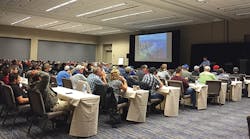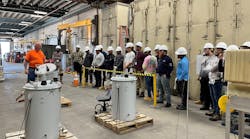Twenty-five years ago, Tennessee lineman Lee Shelby lost both of his hands in an electrical contact accident. As he stood in front of more than 200 linemen at the 2016 rodeo safety conference with his prosthetic limbs, he drove home this message: no job is urgent enough to not do it safely.
Back in 1991, when he was 28 years old, he cut a secondary with a bolt cutter and leather gloves. After he made contact, he hit the bottom of the bucket and was rushed to a burn unit in Memphis, Tennessee. He then spent 23 days in the burn unit, seven months in rehab and occupational therapy, and 10 months and 23 days away from work.
Looking back, he remembers passing the bin with his rubber gloves and consciously deciding not to put them on. On that day, he says he was responsible for his own safety, and that one decision changed everything.
“My accident will be hundreds of thousands of dollars that will keep on accumulating until they put me into the ground,” Shelby says. “The industry we work in is dangerous, and we only get one shot. If you screw up, you may not come home tonight.”
Shelby delivered the keynote address, “Triumph Over Tragedy,” to kick off the annual day-and-a-half safety conference preceding the 2016 Lineman’s Expo and Rodeo. During his talk, he not only focused on his actual accident, but also on the lifelong impact it has had on him and his family.
“Imagine not being able to put your hand on your wife’s face or hold your child’s hand because you made the decision to violate the safety manual,” Shelby says. “When you come into this trade, you have to understand what happens to you if you make a stupid decision. If you have a near-miss, it’s a gift. If you have an accident like I did, however, your hands will never grow back — they’re gone forever.”
Vic Taylor, safety and training conference chairperson, says every year the conference begins with a personal story to inspire the linemen to work safely. In addition, the conference planning committee also tries to look at the current industry trends and areas of interest to linemen and their companies.
“This conference is about them and for them, and we want to make sure it is engaging, informative and something they want to attend again,” says Taylor, the director of safety and training for Kansas City Power & Light.
Understanding Electrical Burns
Following Shelby’s keynote, Dr. Richard Korentager, a surgeon at the burn and wound surgery department at the University of Kansas Medical Center, educated the linemen about electrical burns.
“They are an unfortunate result of the industry we work in, and we thought it was important to understand the complexity, technology, and processes to best treat the unfortunate accidents that do occur.”
Each year, Korentager says about 2,500 patients are treated in the outpatient clinic and about 43% of the burn admissions are related to electrical injuries. When a lineman makes electrical contact, it’s not unusual for him or her to sustain a fourth-degree burn, which affects the skin as well as the muscle, bone, tendon and joint.
“Unlike other injuries, burns progress and get worse,” Korentager says. “Someone who has suffered a burn injury may look like they are going to heal, but they may end up in the operating room. That’s the unusual thing about the pathology of these injuries.”
The fourth-degree burns require more complex forms of reconstruction, he says. Like a large caliber gunshot wound, high-voltage electrical burns have an entry point and an exit point. He likened them to an iceberg, with the skin on top and the most severe injuries below the surface.
“Whenever you work around high voltages, you can’t let your guard down for a minute,” he says. “The current travels deeply through the body, and what you see on the surface is not the extent of the damage. When you make electrical contact, it’s like standing near an explosive device because it can rupture eardrums and collapse lungs.”
Linemen are also at risk if they try to help a shock victim on a job site. If they try to pull them away, they can become victim number two, he says. Instead, he says linemen must try to think about their own safety.
“With the electrical injury, muscles contract and they won’t let go because the current is continuing,” he says. “If you touch the person, you will also suffer an electrical injury.”
Instead, linemen must call an ambulance and have the victim taken to the nearest burn unit. At a medical center, the doctor will remove the smoldering clothing and accessories and keep the patient warm with a space blanket. Patients also must continue to return for long-term follow-up visits.
“Electrical injuries can take seconds to occur,” Korentager says. “The most important thing is to do anything you can do to prevent the injury.”
Working Safely
Along with focusing on electrical burn injuries, the safety conference also zoned in on equipment safety. While equipment continues to improve, it is only a tool to get work done, Taylor says. As such, linemen must understand how equipment functions and how to properly operate and maintain it.
“We like to talk about equipment, and equipment continues to improve,” Taylor says. “It’s only a tool, however, and we need to understand how it functions and how to properly operate and maintain this equipment.”
Darren Hinnergardt, senior Sentry program manager for Altec Industries, talked about the importance of properly inspecting aerial equipment. For example, linemen must check the condition of cylinder pins, pedestal bolts, hoses and tubes. In addition, they must monitor tire pressure, ensure the horn is working properly and check the controls.
“New guys don’t know any better, and the old guys have been there and done that,” Hinnergardt says. “You always have to look out for your buddy because he is looking out for you.”
Another way linemen can protect themselves and their coworkers is through tailgate pre-job meetings. Taylor says these help to plan for unforeseen events. “If you identify hazards and the mitigation for those hazards, you can create a successful outcome no matter how simple or complex,” Taylor says. “You must plan the work and work the plan.”
While pre-job briefing forms can start off as useful tool to get everyone on the same page, they are often the first piece of paper that management looks at when something bad happens, says Mark Yeaston, who spoke at the conference.
“The problem is that we look at safety as an outcome,” Yeaston says. “The fact of the matter is that you create safety as you address hazards as you’re working.”
Another area that the safety conference often covers is human and organizational performance. By focusing on this topic, it gives people a better understanding of how the human mind works and how it interacts with a company and its hazards, Taylor says. As such, Todd Conklin delivered a presentation on “Better Questions” to kick off the second day of the conference.
Preventing Incidents
During the conference, the speakers also highlighted the topic of prevention. For example, Tony Kackowski, the president of InSite Health, came to talk to the linemen about the science and reasoning of stretching and strengthening. During his session, he led the linemen through a series of stretches, which drove the importance of stretching and staying in shape, Taylor says.
“We are not getting any younger, and we put our bodies in awkward positions to do certain jobs,” Taylor says. “We must make sure that we are prepared to function.”
In addition, the conference also focused on the issue of staying safe in the field. Dana Kreeger from the FBI delivered a talk on “Personal Safety and Self Defense.” Taylor says it’s important for linemen to be able to protect themselves.
“Because we work in the public so often, we get exposed through the nature of our work, and we must be best prepared for the unfortunate events,” Taylor says. “If people don’t understand, they may act inappropriately, and we must prepare ourselves for it.”
Along with public safety, another preventative measure is that of wearing personal protective equipment and fall protection. In this vein, Danny Raines of Raines Safety Utility Solutions gave the linemen an update on the OSHA fall protection standard—1910.269.
During the conference, Pat Lavin, business manager for the IBEW Local 47, also urged the linemen to be safe in the field.
“If we don’t take care of our work, no one will do it for us,” he says. “Be careful out there. Our work is hard enough without making it harder by throwing caution to the wind.”
Editor’s note: Visit www.tdworld.com/electric-utility-operations to view a photo gallery from the safety conference.


